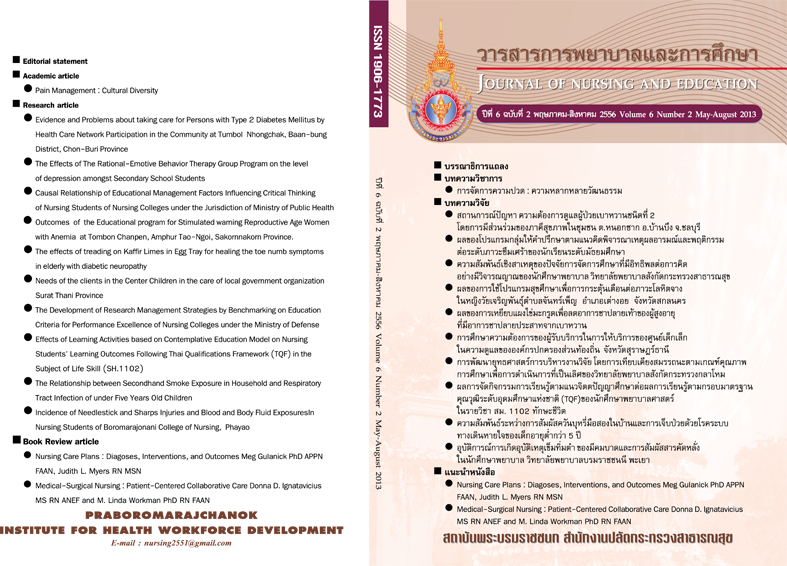อุบัติการณ์การเกิดอุบัติเหตุเข็มทิ่มตำ ของมีคมบาด และการสัมผัส สารคัดหลั่งในนักศึกษาพยาบาล วิทยาลัยพยาบาลบรมราชชนนี พะเยา
คำสำคัญ:
Needlestick injury, sharp injury, blood and body fluid exposures, nursing studentsบทคัดย่อ
บทคัดย่อ
การเกิดอุบัติเหตุเข็มทิ่มตำ ของมีคมบาดและสัมผัสสารคัดหลั่งขณะปฏิบัติงาน มีโอกาสเกิดขึ้นได้บ่อยในบุคลากรสาธารณสุข โดยเฉพาะกลุ่มนักศึกษาพยาบาล แต่รายงานการเกิดอุบัติการณ์การถูกเข็มทิ่มตำ ของมีคมบาดและสัมผัสสารคัดหลั่งในนักศึกษาพยาบาลยังไม่แพร่หลาย การวิจัยครั้งมีวัตถุประสงค์เพื่อศึกษาอุบัติเหตุ กิจกรรมการพยาบาลที่ทำให้นักศึกษาพยาบาลถูกเข็มทิ่มตำ ของมีคมบาดและการสัมผัสสารคัดหลั่ง และการปฏิบัติของนักศึกษาหลังถูกเข็มทิ่มตำ ของมีคมบาดและการสัมผัสสารคัดหลั่ง กลุ่มตัวอย่างคือนักศึกษาพยาบาลศาสตร์ ชั้นปีที่ 4 จำนวน 129 คน เก็บข้อมูลโดยใช้แบบบันทึกที่ผู้วิจัยดัดแปลงมาจากแบบบันทึกอุบัติเหตุจากการปฏิบัติงานของบุคลากรทางสุขภาพ กระทรวงสาธารณสุข
ผลการวิจัยพบว่า กลุ่มตัวอย่าง เป็นเพศหญิง ร้อยละ 87.60 อายุเฉลี่ย 23.40 ปี ร้อยละ 34.88 เคยได้รับอุบัติเหตุถูกเข็มทิ่มตำ ของมีคมบาดหรือสัมผัสกับสารคัดหลั่ง ระหว่างการฝึกปฏิบัติในปีที่ 2-4 อุบัติเหตุส่วนใหญ่เกิดในโรงพยาบาลทั่วไป ร้อยละ 51.10 โดยแบ่งเป็นการถูกของแหลมคมที่ปนเปื้อนเลือดหรือสารคัดหลั่งจากผู้ป่วยทิ่มตำร้อยละ 57.69 ซึ่งเป็นเข็มฉีดยาร้อยละ 62.23 และเกิดอุบัติเหตุขึ้นขณะที่กำลังใช้ของมีคม ร้อยละ 28.85 เกิดอุบัติเหตุขณะปลดเข็ม ถอดอุปกรณ์ ร้อยละ 21.54 เกิดอุบัติเหตุขณะดูดเสมหะด้วยเครื่องดูดเสมหะร้อยละ 21.54 และร้อยละ 13.46 เกิดอุบัติเหตุเมื่อสวมปลอกเข็มกลับ อวัยวะที่ได้รับ
บาดเจ็บมากที่สุดคือที่นิ้วมือ ร้อยละ 86.67 ขณะเกิดอุบัติเหตุไม่ได้สวมเครื่องป้องกันร้อยละ 55.60
กลุ่มตัวอย่าง ร้อยละ 51.10 ไม่ได้รายงานการเกิดอุบัติเหตุให้ผู้เกี่ยวข้องทราบ ไม่ทราบผลเลือดผู้ป่วย
ร้อยละ 48.89 และไม่ได้รับการตรวจเลือดหลังได้รับอุบัติเหตุ ร้อยละ 86.70 และได้รับยาต้านไวรัส เอชไอวี ร้อยละ 6.70
สถาบันการศึกษาพยาบาลและแหล่งฝึกภาคปฏิบัติควรจัดทำหรือเผยแพร่แนวทางการป้องกันการเกิดอุบัติเหตุขณะปฏิบัติงาน และขั้นตอนการปฏิบัติเมื่อได้รับอุบัติเหตุจากเข็มทิ่มตำ ของมีคมบาด หรือสัมผัสกับสารคัดหลั่ง เพื่อป้องกันและควบคุมการแพร่กระจายเชื้อ และความปลอดภัยของนักศึกษาพยาบาล
คำสำคัญ : อุบัติเหตุเข็มทิ่มตำ ของมีคมบาด การสัมผัสสารคัดหลั่ง นักศึกษาพยาบาล
Abstract
Incidence of needlestick and sharps injuries, and blood and body fluid exposures have been commonly found in healthcare workers, particularly in nursing students. There were, however, few studies focused on the incidence of needlestick and sharp injuries, and blood and body fluid exposures among nursing students. This study aimed to describe the incidence of accidents, nursing procedures inducing needlestick, sharp injuries, and blood and body fluid exposures in nursing students and to study nursing students actions after they experienced needlestick injuries or sharp injuries or blood and body fluid exposures. There were 129 forth-year nursing students of Boromarajonani College of Nursing, Phayao participated the study. The data collection was done by using a questionnaire modified from the Accident Records and Reports of Healthcare Personnel, Ministry of Public Health, Thailand.
The results showed that the majority of sample was female 87.60 percent, mean age 23.40 years, and 34.88 percent reported they got needlestick or sharp injuries, or blood and body fluid exposures during clinical practice from the second to the fourth year of study. Most accidents were found in general hospitals which consisted of contaminated sharp injuries 57.69 percent and 62.23 percent were needlestick injuries. The study also revealed that the common accidents were happened while the participants were using sharps, disposing needles, suctioning, and recapping contaminated needles, respectively. Fingers, 86.67 percent, were the most target organ from injuries. The participants reported that they did not use protective devices, when they were experiencing accidents (55.60 percent) and 51.10 percent did not report the accidents to any relevant persons, 48.89 percent of participants did not know patients’ blood results and 86.70 percent did not check their blood after having accidents. There was only 6.70 percent of participants received antiretroviral treatments after getting accidents.
Nursing institutions and training hospitals should develop or distribute a practice guideline for accident prevention during clinical practice. In addition, an implementation of clinical procedures after getting needlestick or sharp injuries or blood and body fluid exposures should be encouraged in order to promote safety and infection control prevention for nursing students.
Keywords : Needlestick injury, sharp injury, blood and body fluid exposures, nursing students






